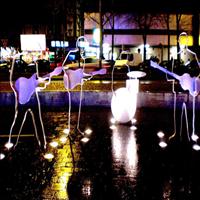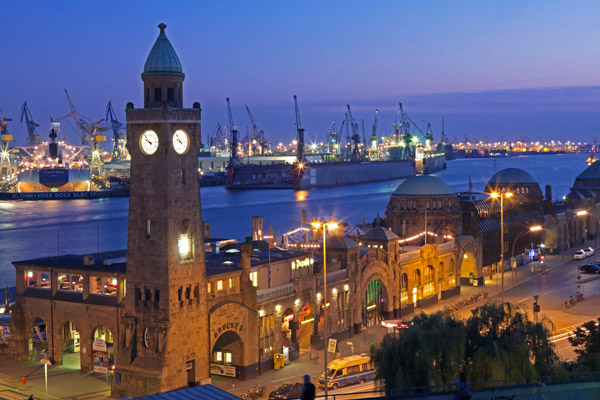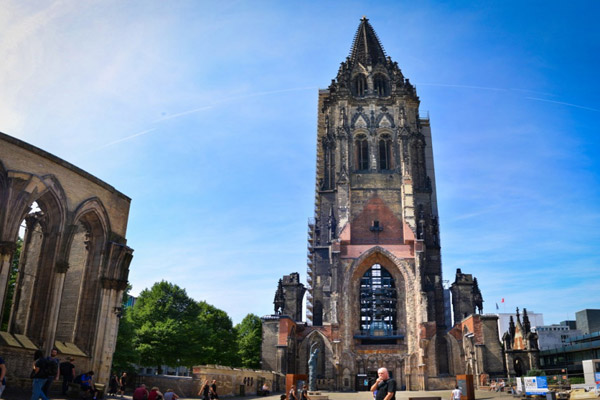Hamburg
City of Hamburg
General Information
Other Name: Free and Hanseatic, , State: Hamburg, Germany
Area: 755 km²
Languages Spoken: German and English
Long Distance Code: +49 40
Importance: The city has the highest GDP in Germany, €50,000 per capita, and has the highest employment rate, with 88 percent of the working-age population. The city is home to over 120,000 enterprises
Best Time to Visit: March to May and October
International Access: Very much connected with rest of the world.
Description
Hamburg is the second-largest city in Germany (after Berlin) and along with its central port, also the second-largest port in Europe (after Rotterdam), ninth-largest port in the world, and the most populous city in the European Union which is not a national capital.Location
Hamburg is located on the southern point of the Jutland Peninsula, directly between Continental Europe to its south, Scandinavia to its north, the North Sea to its west, and the Baltic Sea to its east.Climate
Continental Climate
 Without a doubt, Carl Hagenbeck’s Tierport is one of the premier zoos in Europe. The zoo has a long history dating back to 1848 and is home to over 2,000 animals. The beautifully landscaped parks that make up the zoo are perfect for spending the day. Kids will love Hamburg’s zoo too. There are dolphin shows, elephant rides, and camelback rides in addition to many other shows and tours. The train ride through “fairyland” is enjoyable and a nice break from walking all day.
Without a doubt, Carl Hagenbeck’s Tierport is one of the premier zoos in Europe. The zoo has a long history dating back to 1848 and is home to over 2,000 animals. The beautifully landscaped parks that make up the zoo are perfect for spending the day. Kids will love Hamburg’s zoo too. There are dolphin shows, elephant rides, and camelback rides in addition to many other shows and tours. The train ride through “fairyland” is enjoyable and a nice break from walking all day.
 The Kunsthalle is amongst Germany’s leading art museums. This museum contains works from various German impressionists. In addition, there is a wing devoted solely to contemporary art. A must see is the Altarpiece painted for St. Petri church in 1379 by Master Bertram (Hamburg’s first famous painter). The Altarpiece depicts a biblical story of human kinds creation. Germany has a rich and diverse history; however, much is overshadowed by Germany’s role in the World Wars. The Kunsthalle is the perfect place to discover Germany.
The Kunsthalle is amongst Germany’s leading art museums. This museum contains works from various German impressionists. In addition, there is a wing devoted solely to contemporary art. A must see is the Altarpiece painted for St. Petri church in 1379 by Master Bertram (Hamburg’s first famous painter). The Altarpiece depicts a biblical story of human kinds creation. Germany has a rich and diverse history; however, much is overshadowed by Germany’s role in the World Wars. The Kunsthalle is the perfect place to discover Germany.
 At the southern end of Hamburg stands the remains of the impregnable St. Nikolai church. The gothic style church was built in the 19th century at which time it was an architectural masterpiece. St. Nikolai is one of the few remaining landmarks from prewar Hamburg. After heavy raids by Allied forces in 1943, St. Nikolai was virtually the only structure left standing in the city center. The church was left blackened with soot and partially destroyed. The ruins were left standing in order to serve as a memorial to the victims of persecution in the Third Reich. While visiting Hamburg, you’ll be hard pressed not to visit St. Nikolai whose spiral reaches towards the heavens. The site is gloomy, but interesting. You may be intrigued enough to spend a ½ hour or so exploring the ruins.
At the southern end of Hamburg stands the remains of the impregnable St. Nikolai church. The gothic style church was built in the 19th century at which time it was an architectural masterpiece. St. Nikolai is one of the few remaining landmarks from prewar Hamburg. After heavy raids by Allied forces in 1943, St. Nikolai was virtually the only structure left standing in the city center. The church was left blackened with soot and partially destroyed. The ruins were left standing in order to serve as a memorial to the victims of persecution in the Third Reich. While visiting Hamburg, you’ll be hard pressed not to visit St. Nikolai whose spiral reaches towards the heavens. The site is gloomy, but interesting. You may be intrigued enough to spend a ½ hour or so exploring the ruins. Hamburg’s port is Germany’s busiest in addition to being Hamburg’s main tourist attraction. The Port of Hamburg is a must visit. The port offers tourists many options. The boardwalk is lined with numerous cafes and souvenir shops. Harbor tours are available year round. Tickets for tours can be purchased at the main tourist office beside the Old Elble Tunnel, an astonishing passage way under the Elble River. In addition to providing a picturesque view of the harbor, there are a few worthwhile ship museums including the Rickmer Rickmers and the Cap San Diego. Both are open daily from 10 am to 6 pm. In May the port celebrates it’s anniversary with a three-day festival that includes a parade and a magnificent fireworks display over the harbor. The Fish Market is open Sunday mornings from 5 am to 9:30 am (November 16th - March 14th). Everything from freshly caught fish to live poultry is offered. The market has been in operation since 1703 and with its distinct early morning pub draws and lively crowd.
You’ll need at least a full afternoon to explore Hamburg’s Port. The crowds are minimal. However, there is a lot of ground to cover.
You’ll need at least a full afternoon to explore Hamburg’s Port. The crowds are minimal. However, there is a lot of ground to cover.
 The St. Pauli district was originally set a side for the sailors from around the world who came through Germany's biggest port during the mid 1800's. The sailor's antics were unwanted in other areas of the city. The establishment of the St. Pauli district was an attempt to keep the sailors isolated from the respectable German class. During this time whiskey bars began to take a foothold on the area. Who'd have guessed that the Reeperbahn would grow to become Hamburg's second largest tourist attraction?
The St. Pauli district was originally set a side for the sailors from around the world who came through Germany's biggest port during the mid 1800's. The sailor's antics were unwanted in other areas of the city. The establishment of the St. Pauli district was an attempt to keep the sailors isolated from the respectable German class. During this time whiskey bars began to take a foothold on the area. Who'd have guessed that the Reeperbahn would grow to become Hamburg's second largest tourist attraction?
Despite its seedy appearance, the Reeperbahn is heavily policed and actually one of the safest parts of Hamburg. You can’t help but have a good time in the Reeperbahn. Check out one of the happening pubs where you’ll find heaps of young Germans grooving to the sounds of bands performing popular American tunes.







